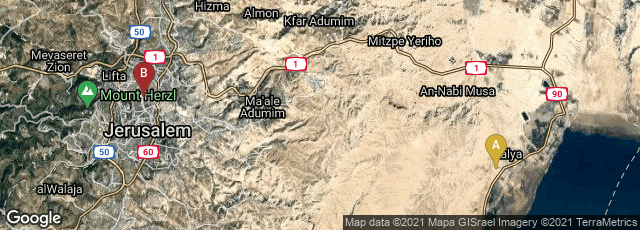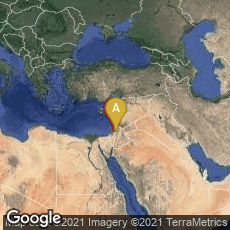

A: (31.740833,35.458611), B: Jerusalem, Jerusalem District, Israel
In 1947 young Bedouin shepherds, searching for a stray goat in the Judean Desert, entered a long-untouched cave and found jars filled with ancient scrolls. This initial discovery by the Bedouins yielded seven scrolls and began a search that lasted nearly a decade. During the same years, archaeologists searching for a habitation close to the caves that might help identify the people who deposited the scrolls, excavated the Qumran ruin, a complex of structures located on a barren terrace between the cliffs where the caves were found on the West Bank and the Dead Sea. In the Qumran ruin archaeologists found the Dead Sea Scrolls—a collection of 972 texts from the Hebrew Bible, and extra-biblical documents.
"The scrolls were found in a series of eleven caves around the [Qumran] settlement, some accessible only through the settlement. Some scholars have claimed that the caves were the permanent libraries of the sect, due to the presence of the remains of a shelving system. Other scholars believe that some caves also served as domestic shelters for those living in the area. Many of the texts found in the caves appear to represent widely accepted Jewish beliefs and practices, while other texts appear to speak of divergent, unique, or minority interpretations and practices. Some scholars believe that some of these texts describe the beliefs of the inhabitants of Qumran, which, may have been the Essenes, or the asylum for supporters of the traditional priestly family of the Zadokites against the Hasmonean priest/kings. A literary epistle published in the 1990s expresses reasons for creating a community, some of which resemble Sadducean arguments in the Talmud. Most of the scrolls seem to have been hidden in the caves during the turmoil of the First Jewish Revolt, though some of them may have been deposited earlier" (Wikipedia article on Qumran, accessed 11-30-2013).
In September 2011 The Digital Dead Sea Scrolls website, a partnership between the Israel Museum in Jerusalem and Google, made five of the scrolls searchable online as part of a project to provide searchable online facsimiles of all the scrolls.
In December 2012 the Leon Levy Dead Sea Scrolls Digital Library was launched by the Israel Antiquities Authority in partnership with Google Israel, making high resolution images of the scrolls freely available. The site was launched 11 years after the completion of the publication of the Dead Sea Scrolls, initiated and sponsored by the IAA, and 65 years after the first scrolls were unearthed in the Caves of Qumran.